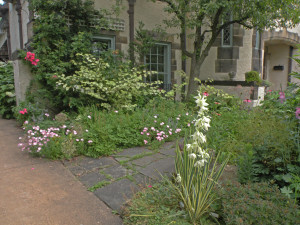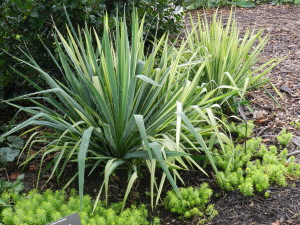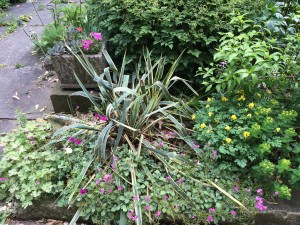
Repetition of white and pink: Fallopia japonica ‘Variegata’ and Yucca ”Bright Edge’in my garden in mid June
If you were asked which perennial is best suited for sunny dry locations, what would your answer be? Mine would be Yucca filamentosa. Commonly known as Adam’s Needle, Spanish Bayonet, and Dagger Plant, this tough perennial is undemanding with one exception – excellent drainage and you can achieve that by using enlarged aggregate in the soil mix. There are other yucca species but most of them are not hardy to zone 5 like this one.
This perennial has many other assets. One is its form, extremely architectural when in bloom but also unusual when not in bloom. Where else will you find triangular, fleshy, sword-like foliage? In addition, the foliage is often spiky, definitely a deer deterrent. However, I would advise not planting yucca in areas frequented by children. The margins of the leaves often have very narrow, thread-like, twisty filaments, thus the species name.

Color echo of Yucca ‘Color Guard’, coleus, and Lysimachia nummularia ‘Aurea’ in Virginia garden in October

Yucca filamentosa ‘Golden Sword’ with Sedum ‘Angelina’ at Cylburn Arboretum in Baltimorein late July
Another is its evergreen foliage, not really green but blue or variegated depending on the cultivar. One of my favorites is ‘Color Guard’ which has a wide creamy yellow stripe down the middle of the leaf. The color intensifies during the winter and looks great in the snow. ‘Golden Sword’ is similar but the stripe is not as wide. Using the element of color echo, both look great when skirted with Sedum ‘Angelina’. They also benefit from being planted in a sea of Sedum kamschaticum, green foliage with yellow flowers in July.

Arabis caucasica ‘Compinkie’, Yucca ‘Bright Edge’, Corydalis lutea in my garden in late May
I’ve had Yucca ‘Bright Edge’ in a corner of my garden for seventeen years and nearby is the delicate foliage and bright yellow flowers of Corydalis lutea that seeds about – another great example of color echo. As a foil, nearby are the magenta-flowered Arabis caucasica ‘Spring Charm’ and Geranium cinereum ‘Purple Pillow’. These two perennials bloom in May so I continue the magenta theme for the summer with New Guinea Impatiens in a nearby container. All of these cultivars have foliage that grows about two feet high and wide. The four to five foot flower stalk will rise up with large, pendant white bells. Be careful when purchasing any of these variegated cultivars because many of the labels are incorrect. Twice I thought I was buying ‘Color Guard’ but what I received was ‘Bright Edge’.

Xeriscape with juniper, Yucca ‘Hofer’s Blue’, Opuntia, and Rhus laciniata in garden on Lake Erie in mid June
If steel blue is the color you want, try ‘Hofer’s Blue’. This cultivar is a bit larger at three feet high and wide while the large flowered spike that appears in June and July will stretch to six feet. These flowers are creamy white.
The only drawback I have ever found with yucca is the strong, pervasive roots. At some point, you may decide that you want to transplant it. Although you may think you dug all of the root system, chances are that you left some and new plants will appear. Otherwise, this is the perfect plant for that unirrigated spot where nothing else will grow.


0 Comments